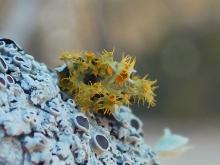Mosses, Liverworts, and Lichens
Media

Species Types
Scientific Name
Teloschistes chrysopthalmus
Description
Gold-eye lichen is quite small but easy to identify. It grows on twigs and small branches. It is shrubby with yellowish branching stalks. The apothecia disks are bright orange and have spiny-looking appendages around the rim.
Media

Species Types
Scientific Name
Thuidium spp.
Description
Easy to identify, fern mosses look like tiny ferns. Just like many fern fronds, the branches lie on one plane and become shorter toward the tips. They even lean over like fern fronds.
Media

Species Types
Scientific Name
Candelaria spp.
Description
Candleflame lichens (Candelaria spp.) are tiny to small, greenish-yellow foliose lichens that grow in a branching, rosette form. Missouri species typically live on tree trunks.
Media

Species Types
Scientific Name
Xanthoria spp. (also Xanthomendoza; Polycauliona)
Description
Orange sunburst lichens are orange or yellow orange. They have a circular, foliose growth pattern with tiny, branching lobes, but this pattern is often lost when these lichens form masses of tiny scale-like fragments. They can be very common on sunny rocks and tombstones.
Media

Species Types
Scientific Name
Acarospora spp.
Description
Cobblestone lichens , or cracked lichens, grow flat against their substrate and are textured like lumpy cobblestone streets or old, cracked paint, or they are broken into sections like the mud of a dried lake. Depending on species, the color can range from white to greenish gray to brown to bright yellow.
Media

Species Types
Scientific Name
About 436 species in Missouri
Description
A lichen is a composite organism formed by certain fungus species that join with certain algae species. Lichens can be many colors and can be crusty, leaflike, flaky, branching, or mossy. They grow on rocks, trees, or other surfaces.
Media

Species Types
Scientific Name
Caloplaca spp.
Description
Firedot lichens are usually orange, yellow, rusty, or brown and look like tiny dots on a surface. To see these crustose lichens well, you often must get on your hands and knees and use a hand lens.
Media

Species Types
Scientific Name
Candelariella spp.
Description
Goldspeck lichens are orange to yellow crustose lichens that are frequently seen growing on rocks, wood, or other substrates. Missouri has about three species.
Media

Species Types
Scientific Name
Ditrichum pallidum
Description
Golden thread moss forms small, light green or yellowish, rounded, fuzzy-looking hummocks like a cat’s paws. The sporophytes are on remarkably long, slender, yellow, almost translucent stalks.
See Also
About Mosses, Liverworts, and Lichens in Missouri
Mosses, liverworts, hornworts, and lichens seem rather similar, but these organisms are in very different groups. Mosses, liverworts, and hornworts are small, low plants usually found in damp habitats. Unlike more familiar plants, they lack veinlike structures and do not produce flowers or seeds — instead, they produce spores. Meanwhile, lichens are not plants at all: they are a collection of different fungi that have photosynthetic algae living within their tissues.





















